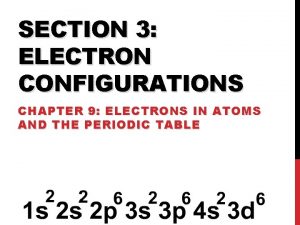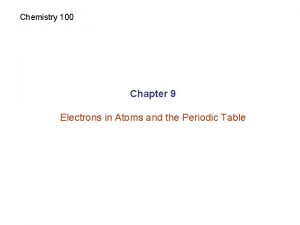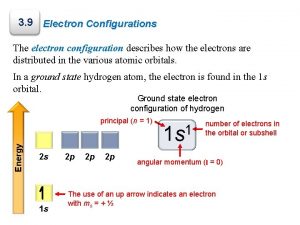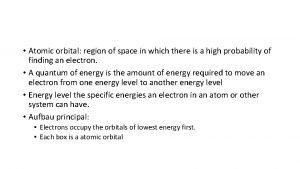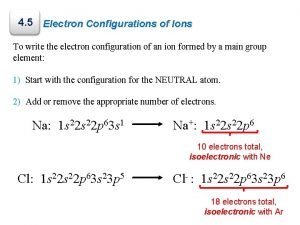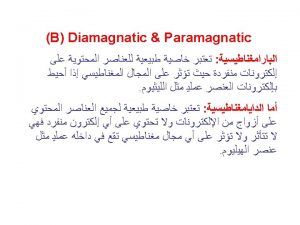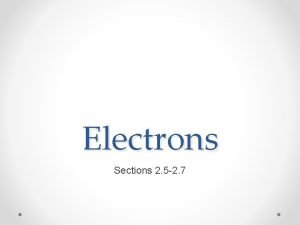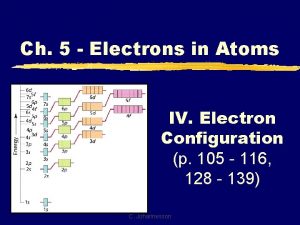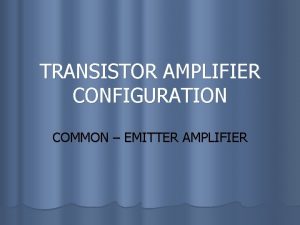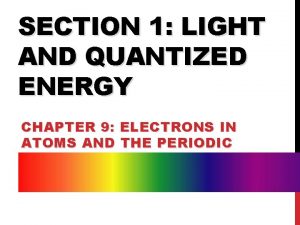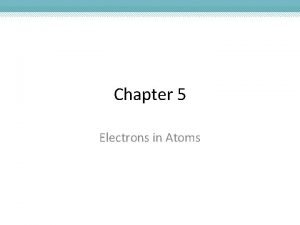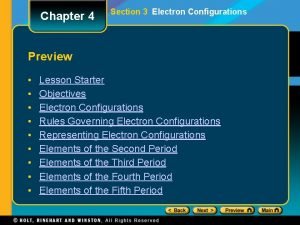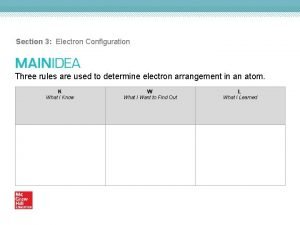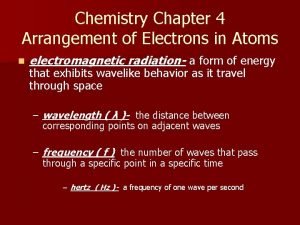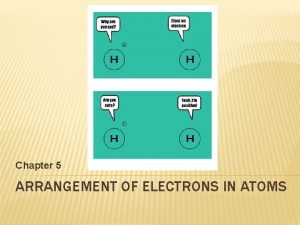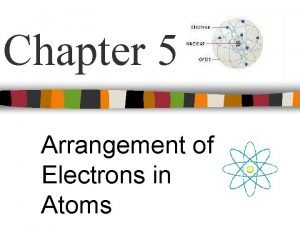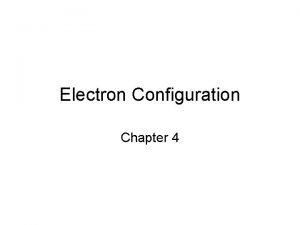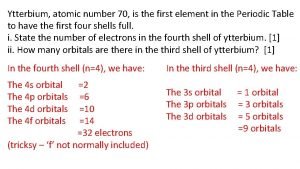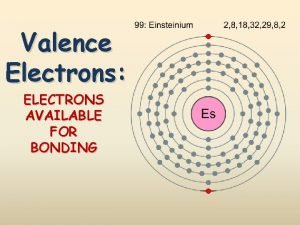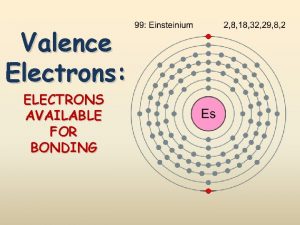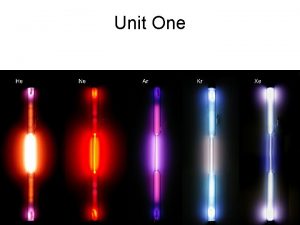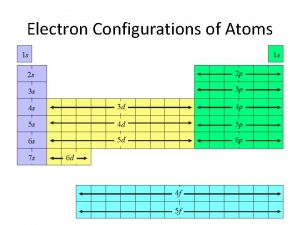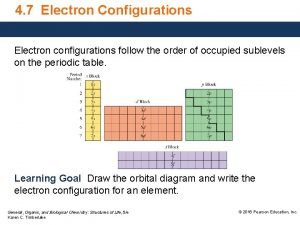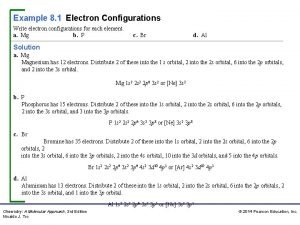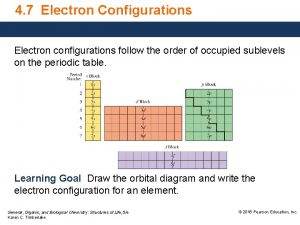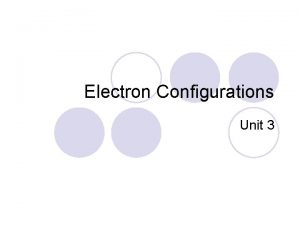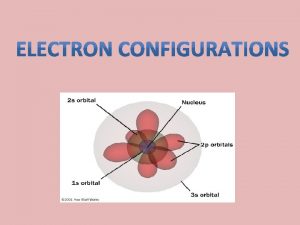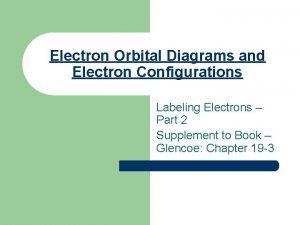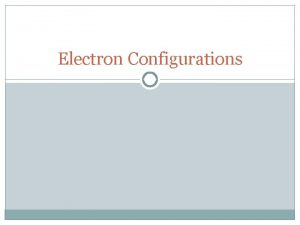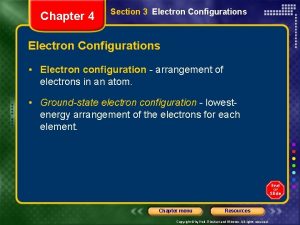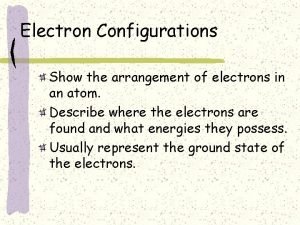SECTION 3 ELECTRON CONFIGURATIONS CHAPTER 9 ELECTRONS IN












































![Electron Configuration • Chromium: 1 5 [Ar]4 s 3 d • Copper: [Ar]4 s Electron Configuration • Chromium: 1 5 [Ar]4 s 3 d • Copper: [Ar]4 s](https://slidetodoc.com/presentation_image_h/91e9df93309af9dc382e8b12019a6b98/image-45.jpg)


- Slides: 47

SECTION 3: ELECTRON CONFIGURATIONS CHAPTER 9: ELECTRONS IN ATOMS AND THE PERIODIC TABLE

Learning Goals • Apply the Pauli exclusion principle, the aufbau principle, and Hund's rule to write electron configurations using orbital diagrams and electron configuration notation.

Electron Configuration • An electron configuration shows how the electrons occupy the orbitals for a particular atom. • The aufbau principle states that each electron occupies the lowest energy orbital available.

1 s orbital 2 electrons

2 s orbital 2 electrons

2 p orbital 6 electrons

3 s orbital 2 electrons

3 p orbital 6 electrons

4 s orbital 2 electrons

3 d orbital 10 electrons

4 p orbital 6 electrons

5 s orbital 2 electrons

4 d orbital 10 electrons

5 p orbital 6 electrons

6 s orbital 2 electrons

4 f orbital 14 electrons

5 d orbital 10 electrons

6 p orbital 6 electrons

7 s orbital 2 electrons

5 f orbital 14 electrons

6 d orbital 10 electrons

7 p orbital 6 electrons



Electron Configuration • Hund’s rule states that single electrons must occupy each equalenergy orbital before additional electrons with can occupy the same energy level orbitals. • All electrons in singly occupied orbitals must have the same spin. • School bus rule


Electron Configuration • The Pauli exclusion principle states that a maximum of two electrons can occupy a single orbital, but only if the electrons have opposite spins. • We symbolize this as two arrows pointing in opposite directions.



Orbital Notation Examples • Write the orbital notation electron configuration for the following atoms or ions. State how many unpaired electrons are in each. a. N b. Cl

Orbital Notation Examples c. Al d. V

Orbital Notation Examples e. Li+ f. 2 O

Electron Configuration • Electron Configurations Using the Periodic Table: • Read the periodic table from left to right to determine the electron configuration.



Electron Configuration • Write the ground state electron configuration for the following: a. C b. Fe

Electron Configuration c. W d. S 2 -


Electron Configuration • Noble gas notation uses noble gas symbols in brackets to shorten inner electron configurations of other elements. • The noble gas must have a lower atomic number than the atom or ion that the electron configuration is being written for.

Noble Gas Notation a. W b. Eu

Noble Gas Notation c. As d. O



Electron Configuration • The aufbau diagram can be used to write correct ground-state electron configurations for all elements up to and including Vanadium, atomic number 23. • The electron configurations for certain transition metals, like chromium and copper, do not follow the aufbau diagram due to increased stability of half-filled and filled sets of s and d orbitals.
![Electron Configuration Chromium 1 5 Ar4 s 3 d Copper Ar4 s Electron Configuration • Chromium: 1 5 [Ar]4 s 3 d • Copper: [Ar]4 s](https://slidetodoc.com/presentation_image_h/91e9df93309af9dc382e8b12019a6b98/image-45.jpg)
Electron Configuration • Chromium: 1 5 [Ar]4 s 3 d • Copper: [Ar]4 s 13 d 10 • These exceptions occur because a half-filled d subshell and a completely filled d subshell are particularly stable

Electron Configuration • The number of outer-shell electrons in a transition series does not change as you move across a period. • The transition series represents the filling of core orbitals and the number of outershell electrons is mostly constant—either 2 or 1.

Electron Configuration (2 e–) for 4 s 23 dx (1 e–) for 1 5 4 s 3 d or 1 10 4 s 3 d
 Electrons in atoms section 3 electron configuration
Electrons in atoms section 3 electron configuration Electrons configurations
Electrons configurations Electrons configurations
Electrons configurations Orbital diagram for ca
Orbital diagram for ca C n o f electron affinity
C n o f electron affinity Stable electron configurations are likely to contain
Stable electron configurations are likely to contain Chapter 5 electrons in atoms
Chapter 5 electrons in atoms Stable electron configurations are likely to contain
Stable electron configurations are likely to contain Electron configurations of ions
Electron configurations of ions Stable electron configurations
Stable electron configurations Electrons
Electrons 1s 22 s22 p63 s2
1s 22 s22 p63 s2 Electron configuration for 5 electrons
Electron configuration for 5 electrons Flexible pavement and rigid pavement
Flexible pavement and rigid pavement Transistor amplifier configurations
Transistor amplifier configurations 1s1 electron configuration
1s1 electron configuration Bipolar transistor uses
Bipolar transistor uses Ceedar innovation configurations
Ceedar innovation configurations Electrons in atoms section 1 light and quantized energy
Electrons in atoms section 1 light and quantized energy Electrons in atoms section 1 light and quantized energy
Electrons in atoms section 1 light and quantized energy The lowest allowable energy state of an atom
The lowest allowable energy state of an atom Electrons in atoms section 2 quantum theory and the atom
Electrons in atoms section 2 quantum theory and the atom Section 3 electron configuration
Section 3 electron configuration Section 3 electron configuration
Section 3 electron configuration Section 3 electron configuration
Section 3 electron configuration Chapter 10 meiosis 1 and meiosis 2
Chapter 10 meiosis 1 and meiosis 2 Chapter 4 arrangement of electrons in atoms
Chapter 4 arrangement of electrons in atoms Chapter 5 review arrangement of electrons in atoms
Chapter 5 review arrangement of electrons in atoms Chapter 5 arrangement of electrons
Chapter 5 arrangement of electrons Chapter 5 arrangement of electrons
Chapter 5 arrangement of electrons Aubfau
Aubfau What is a revolved section view? a revolved section view:
What is a revolved section view? a revolved section view: Section view meaning
Section view meaning What line types are usually omitted from sectional views?
What line types are usually omitted from sectional views? Section 2 describing energy
Section 2 describing energy 70 atomic number
70 atomic number Period 4, metallic, 27 electrons
Period 4, metallic, 27 electrons How many valence electrons are in barium
How many valence electrons are in barium Halogens valence electrons
Halogens valence electrons Group with 6 valence electrons
Group with 6 valence electrons How to find valence electrons
How to find valence electrons Valence lectrons
Valence lectrons How many electrons does oxygen have
How many electrons does oxygen have S22- lewis structure
S22- lewis structure Electrons flow from anode to cathode
Electrons flow from anode to cathode Basic atomic structure worksheet
Basic atomic structure worksheet What is z on the periodic table
What is z on the periodic table Tarantola periodic table
Tarantola periodic table
